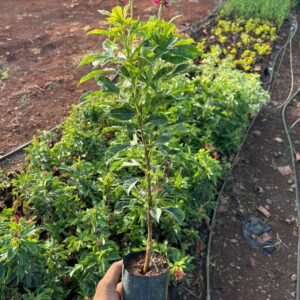Anjeer/Fig 5×6 Plant: A Delicious and Decorative Addition to Your Garden
The Anjeer, commonly known as the Fig (Ficus carica), is a deciduous fruit-bearing tree that typically grows to a height of 5 to 6 feet in its younger form, making it an excellent choice for home gardens and small spaces. Renowned for its sweet and nutritious fruits, the Anjeer plant is not only a source of delicious snacks but also adds aesthetic appeal to any landscape.
Stunning Appearance
The Anjeer plant features broad, lobed leaves that are lush green and can grow quite large, creating a dense canopy that provides shade and a tropical feel to your garden. The leaves have a distinctive texture, with deep veins that enhance their visual interest.
During the growing season, the plant may produce small, inconspicuous flowers that eventually develop into the delicious, tear-drop-shaped figs. Depending on the variety, the figs can range in color from green to purple to black, each offering a unique flavor and sweetness.
Ideal Growing Conditions
Anjeer plants thrive best in well-drained, fertile soil and require full sun for optimal growth. They should receive at least 6 to 8 hours of direct sunlight each day to encourage healthy leaf development and fruit production.
This plant is suitable for USDA hardiness zones 8 to 10, making it ideal for warm climates. In cooler regions, it can be grown in containers and brought indoors during winter, providing versatility for gardeners in various climates.
Versatile Landscape Uses
The Anjeer/Fig plant can be used in various ways in the landscape:
- Ornamental Specimen: Its large, dramatic leaves and the beautiful fruit make it an attractive focal point in gardens.
- Edible Landscape: Planting Anjeer alongside other edible plants creates a productive garden space, allowing you to harvest fruits while enjoying the plant’s ornamental qualities.
- Shade Tree: In larger spaces, the mature Anjeer can provide ample shade, making it perfect for relaxation areas in the garden.
Low Maintenance Requirements
Anjeer plants are relatively low maintenance once established. They are drought-tolerant and require moderate watering, particularly during dry spells. Fertilizing with a balanced fertilizer in early spring can help enhance growth and fruit production.
Pruning is recommended to maintain the shape of the plant and remove any dead or diseased wood. This not only encourages better airflow but also promotes healthier growth and fruiting.
Nutritional Benefits
Figs are not just delicious; they are also packed with nutritional benefits. They are a rich source of dietary fiber, vitamins (such as A, B6, and K), and minerals (including potassium, magnesium, and calcium). Consuming figs can support digestive health, promote heart health, and contribute to overall well-being.
Ecological Benefits
The Anjeer/Fig plant attracts various pollinators, including bees and butterflies, making it a valuable addition to any garden ecosystem. The plant’s dense foliage also provides habitat for birds and small wildlife, contributing to biodiversity in your outdoor space.
Cultural Significance
Figs have significant cultural importance in many regions, symbolizing abundance, fertility, and prosperity. In various cuisines, figs are used in both sweet and savory dishes, adding a unique flavor and texture to meals. They are also often featured in traditional celebrations and festivals.






Reviews
There are no reviews yet.